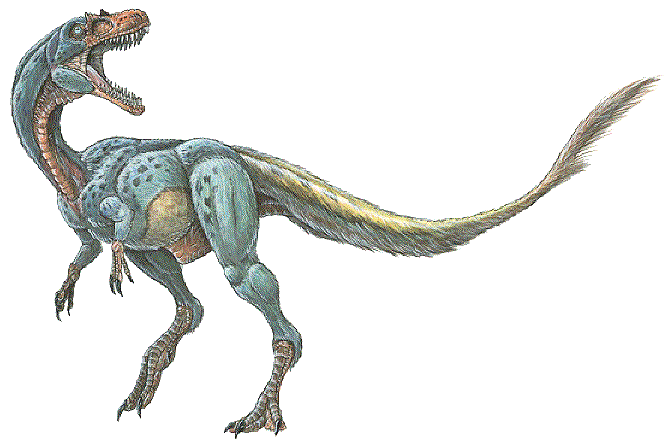|
On October 6, 2004, scientists announced the discovery a tiny, earlier
cousin of Tyrannosaurus rex. What made it unique
was a partial coat of hair-like feathers. Xu Xing of the
Institute of Vertebrate Paleontology and Paleoanthropology in Beijing,
China, is the lead author of the new paper. He said his discovery is
significant because it sheds light on the evolution of tyrannosaurids,
which include the giant carnivore T. rex. "With this new
find, we can see a perfect evolutionary transition from typical
coelurosaurians to highly specialized large tyrannosaurids and clarify
a number of questions," he said.
The description of Dilong paradoxus is based on
the fossils of four specimens, including a fragmented one with
evidence of protofeathers - precursors to the feathers found on modern
birds. The fragmented fossil went unidentified until a more complete
fossil of the same creature was studied and found to match the
morphology, or form and structure, of that found in the earlier
fragments. The fossils come from a geologic feature in northeastern
China known as the Yixian formation, which has yielded several other
feathered dinosaurs.
Mark Norell, a curator and chair of the
division of paleontology at New York's American Museum of Natural
History, co-authored the paper that describes the new species, which
appeared in the science journal Nature. Norell said the
discovery supports theories that dinosaurs were birdlike, warm-blooded
creatures that evolved feathers to stay warm - not to fly.
"It's the kind of thing we expected, but we thought we might never
find a fossil that would justifiably show it." Xu added
that even large dinosaurs like T. rex may have had feathers
when they were young. "They are not likely to be completely
featherless animals for [their] whole life."
Thomas Holtz, a vertebrate paleontologist at the University
of Maryland in College Park, was among the group of paleontologists to
predict that early tyrannosaurids had feathers. The scientist, who was
not involved in the study, said he is thrilled at the latest find.
"There is a lot of attention given to surprises in paleontology," he
said. "But there is a side to it where we hope to be scientists, and
part of science is based on predictions that are based on the best
evidence at hand. It helps to see predictions pan out with
discoveries." The predictions Holtz and other paleontologists
have made are based on skeletal data that suggest tyrannosaurids had a
more recent common ancestor with birds than did Sinosauropteryx,
the most primitive known feathered dinosaur. Sinosauropteryx
lived 120 to 150 million years ago.
Hans-Dieter Sues, the associate director for research
and collections at the Smithsonian Institution's National Museum of
Natural History in Washington, D.C., agrees. "The new small
tyrannosaur definitely shows an interesting mosaic of primitive and
derived features; its skull is already more like that of other, later
tyrannosaurs than the rest of its skeleton," said Sues, who is a
member of the National Geographic Society's Committee for Research and
Exploration. |

